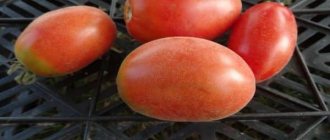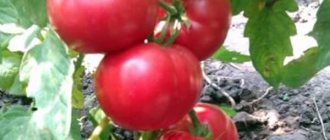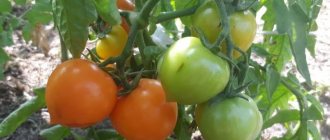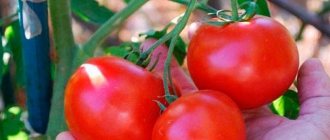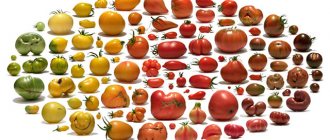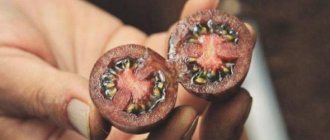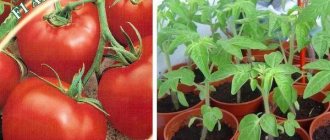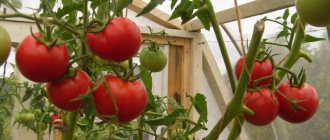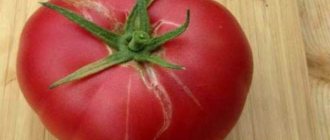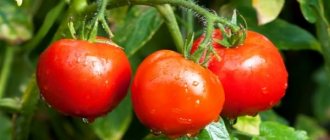Shaggy Keith is a non-standard variety. Its ripe fruits have a blue tint. In addition, pubescence is clearly visible on them. Despite its exotic appearance, the variety has a high yield, delights with excellent taste and the ability to grow in any climate.
| Height | Landing location | Ripening time | Fruit color | Fruit size | Origin | Fruit shape |
| Medium height | Greenhouse, Open ground | Late ripening | Bicolor | Small | Variety | Plum-shaped or oval |
Variety criteria
To create a complete picture, the summer resident is looking for a description of the tomato. This helps to grow the crop correctly and avoid mistakes when planning.
Plant:
- Determinant.
- Height from 0.7 cm to 1 m.
- 4-7 tomatoes in 1 brush.
- Ripens within 115-125 days.
The peculiarity of the variety is that the fruits are pubescent, the leaves and stem are also fluffy.
Tomato:
- Round shape.
- Weight up to 80 g.
- The color is red. Gradually, the shoulders darken, coloring almost the entire fruit.
- The taste is sweetish.
- Contains a large amount of anthocyanin.
- It stores well and withstands transportation.
There is a second variety with the same name. It is distinguished by yellow fruits, a bush height of 70 cm, and the fact that it does not require shaping or staking. The characteristics of the yellow Shaggy Keith show that the variety is late.
Features of agricultural technology
Growing strong, hardened seedlings is most often a necessary condition for obtaining a full harvest
Therefore, it is important for the vegetable grower to control all stages of its preparation himself.
- Pre-sowing treatment includes disinfection of tomato seeds in a solution of potassium permarganate or Fitosporin for 20 minutes. After washing in running water, the seeds are soaked in growth stimulants for 5-6 hours.
- It is advisable to disinfect the soil for growing seedlings - freeze or steam it. It should consist of a mixture of garden soil with compost, ash and mineral fertilizers. If the soil is not light and loose enough, peat or coconut substrate is added to it.
- Seeds are sown into moist soil after 2-3 cm, covered with a layer of earth (5-7mm) and placed in a comfortable warm place (24-25 degrees).
- Immediately after the loops appear, the plants are exposed to light - on window sills or under artificial lighting lamps. During the first two weeks, the temperature regime is quite strict: 15-16 degrees during the day, 12-14 degrees at night.
- During this period, it is necessary to provide the plants with lighting for 11-12 hours a day. Watering should be very moderate to avoid blackleg disease.
- After the hardening period, the temperature is increased by 5-7 degrees, while maintaining maximum illumination.
- When 3-4 true leaves appear, the tomatoes are planted in cups or larger boxes, keeping a distance of 15-20 cm between them. Seedlings are fed as needed, depending on their appearance, 1-2 times during the entire period with mineral fertilizers for seedlings.
Planting seedlings in open ground or in greenhouses begins when stable warm weather sets in.
Tomato seedlings “Negritenok” are planted in a row every 40cm and between rows - every 60cm. If you are planting plants in a greenhouse, it is advisable to increase this distance. When planting, compost, ash, and mineral fertilizers are added to the plants. The seedlings are watered and supports are installed.
Further plant care includes:
- Water every 7-10 days depending on the weather.
- Weeding, loosening.
- Fertilizing for the first 2-3 weeks is done with mullein infusion (or other nitrogen-containing fertilizers); after the formation of ovaries, potassium-phosphorus fertilizers and ash are introduced.
- Tying plants to the trellis, pinching, trimming yellowed leaves at the bottom of the plant. To obtain larger fruits in the first clusters, the plants are formed into one stem.
Greenhouses, when growing tomatoes in them, must be ventilated, and watering must be done directly under the roots of the plants in the morning. Dry air in the greenhouse will help avoid infections and preserve the harvest of these exotic fruits.
How to grow crops correctly?
It is not enough to simply put the seeds in the holes; painstaking work is required to care for the plant. It is recommended to grow in seedlings. This way the plant bears fruit earlier.
Planting material is sown 2 months before transferring to the ground. Each person calculates the deadline individually. Since the climate in each region is different.
It is necessary to care for seedlings, because the future harvest depends on it:
- Seedlings need light 14 hours a day.
- Humidity and air temperature should also be optimal for the growth of seedlings.
- Water as needed, without drying out or waterlogging the soil.
- Feeding with growth stimulants and complex fertilizers.
4 plants per 1m2 are placed in the ground. Requires tying to supports and forming into 3 stems. Further care consists of timely watering, it is advisable to organize drip watering.
See also
Characteristics and description of the Moscow delicacy tomato variety, its yieldRead
Loosening and hilling will provide oxygen access to the roots. Mulching will help retain moisture and prevent weeds and pests.
Advantages and disadvantages of the variety
Summer residents who grew the Negritenok tomato give positive reviews about the taste of the variety, photos of the fruits reflect their unusual appearance, but there is no consensus on the yield of the plants. Apparently, amateurs are not always able to select the necessary growing conditions for this variety.
However, the main advantages of the variety:
- Harmonious, wonderful taste of fruits.
- Original color.
- Versatility of use - in addition to being used fresh, it can be frozen, dried, and made into juices.
- Tomatoes are a storehouse of useful substances, including anthocyanins, which improve vascular function and increase immunity.
- Resistance to many tomato diseases allows harvesting until late, subject to proper agricultural practices.
The disadvantages of the Negritenok variety include an unstable harvest and the need to devote a lot of time to caring for the plant - shaping, gartering, pinching.
Application and yield volume
The uses of tomatoes have a wide range. The fruits are used for any purpose, canning, pickling, drying, making fresh and winter salads, and much more. Housewives decorate the festive table with the fruits of the Shaggy Keith.
The yield is high, following the manufacturer’s recommendations for plant formation, excellent results are achieved.
Description of the tomato variety Vasily, its characteristics and cultivation
Healthy and tasty tomato fruits have long occupied pride of place on the beds and tables of Russians. Vasily f1 tomatoes appeared as a result of domestic selection. The originator was . Breeders have created a tomato that produces a harvest in the shortest possible time.
General information about the plant
Tomatoes of the Vasily variety are distinguished by early harvest. Early ripening made it possible to grow the plant not only in the south of Russia, but also in the central zone of the country. Characteristics of tomato and external description of the plant:
- Hybrid variety.
- Standard.
- Early ripening, the berries are ready for picking 80–85 days from planting.
- Low-growing, the height of the bushes does not exceed 0.6 meters.
- Determinant.
- Good yield.
- Average foliage of bushes.
- Strongly corrugated green foliage.
- Compact.
- Erect stem.
- Medium branched.
- Powerful root system.
- Resistant to weather changes.
- Inflorescences of intermediate type.
- Immunity to most nightshade diseases.
- Long fruiting period.
- Simultaneous harvesting.
- Easy to care for.
- Well preserved.
- It is possible to transport tomatoes without losing their presentation.
The popular Vasily tomato variety is grown by Ukrainian and Moldavian gardeners. Reviews confirm the high percentage of tomato yield. The plant should be cultivated based on the climatic characteristics of the region. Most vegetable growers recommend the greenhouse growing method. Planting tomatoes in open ground is permissible provided that the climatic conditions are suitable for heat-loving plants. Technical data and external features of the fruit:
- Round shape.
- Red color when mature.
- Green color during ripening.
- Small size.
- Average weight is 100 grams.
- Smooth.
- Not prone to cracking.
- Sweet taste, no sourness.
- Juicy, not watery.
- Lasting aroma.
Tomato fruits are suitable for whole-fruit canning and pickling. The universal nature of the berry allows it to be used not only as preparations, but also consumed fresh. The fruits are used as an ingredient for salads and for self-consumption. Its small size makes the variety suitable for decorations and festive table decorations.
Cultivation Tips
The originator recommends the variety for seedling planting. Healthy seedlings are obtained by following simple rules:
- Plant seeds to a depth of 1–2 centimeters.
- Pre-moistening of universal soil for planting nightshade crops.
- Temperature conditions from 21 degrees.
- Timely watering with water at room temperature.
- A lighting source that organizes a 16-hour sunny day.
IMPORTANT! Hardening off seedlings before planting in open ground ensures better tomato yields. The hybrid variety of Russian selection is not demanding in care
To obtain a decent harvest, it is necessary to follow simple rules of agricultural technology: watering, loosening the soil and removing weeds, feeding with complex mineral fertilizer
The hybrid variety of Russian selection is not demanding in care. To obtain a decent harvest, it is necessary to follow simple rules of agricultural technology: watering, loosening the soil and removing weeds, feeding with complex mineral fertilizer.
What makes the view attractive?
The fluffy bush on the site attracts a lot of attention, and its unusual fruits are the subject of controversy. Summer residents, wanting to decorate their gardens and tables, grow such varieties to surprise friends and family.
In addition, the plant is useful, very productive and has the ability to retain the marketable appearance of the fruit after long-term transportation and storage. The versatility of using fruits is also not overlooked.
Tomato Shaggy Kate
photo author Mira Tom
Shaggy Kate red and yellow
Description and characteristics of the tomato variety Shaggy Kate, reviews, photos
Mid-season, determinate, rare tomato variety with pubescent fruits. Recommended for growing in open ground and film shelters.
Bush 0.7-1 meter high, leaves and trunk with pubescence. Requires tying to the support and pinning. The best results are obtained when forming a plant with 3 stems.
Basic qualities of fruits
The fruits are round, pubescent, and at ripeness very decorative - with purple shoulders. This color is given to the fruit by the increased content of anthocyanin. The average fruit weight is 60-80 grams. These tomatoes are not only beautiful, but also healthy, thanks to the presence of a powerful antioxidant.
Features of cultivation
Sowing the seeds of this variety of tomatoes for seedlings is carried out 60-65 days before the intended planting in the ground. When planting seedlings in a permanent place per 1 sq. up to 4 plants are placed per meter of plot.
If you grew Shaggy Kate tomatoes, please write whether you liked them or not. How has this variety performed in your region? What was the yield and taste of the fruit under your conditions? If possible, attach to the comment a photo of the entire bush as a whole or individual fruits that you grew. Thank you!
Your reviews of the Shaggy Kate tomato and additions to the description will help many gardeners evaluate this variety more objectively and decide whether it is worth planting or not.
Varieties of velvet, pubescent tomatoes (peach tomatoes)
The plants of the pubescent varieties themselves look very unusual. If you look from a distance, such a tomato bush seems densely covered with bluish frost that shimmers in the sun. But upon closer examination it turns out that this is not frost at all, but severe pubescence.
Moreover, not only the leaves and branches are covered with long thick hairs, but also the fruits - for which they are nicknamed “peachy tomatoes.”
The most common among the pubescent varieties is Velvet
(other names for this variety are
Chinese Velvet, Chinese Blue, Gray Earl
).
It has pubescent leaves, stem and fruits. The bushes are about 1 m high, the fruits are medium-sized, round, the yield is high, but the variety requires increased care. The structure of the bush is very similar to the well-known variety Money Maker
.
EVERYTHING YOU NEED FOR THIS ARTICLE IS HERE >>>
Tomatoes of the Velvet variety are very decorative with white pubescence of stems, leaves and fruits. The fruits are quite dense, weighing about 150-200 g, red-pink in color, the taste is very good, sweet with a barely noticeable sourness.
It is interesting that strong pubescence is characteristic only of unripe fruits, and when they ripen, there are few fibers on the fruits. This variety is late-ripening, but the ripening of the crop can be accelerated with an increased level of agricultural technology.
Namely, regular watering and fertilizing are needed, which stimulates increased fruit formation even in hot weather. There is also a similar variety of this variety, only the fruits have a richer pink color.
The next variety with pubescent fruits is called Gray Prince. At first glance, it also resembles Velvet, but the Gray Prince bush is up to two meters high, the fruits are red, almost without pubescence, weighing up to 400 g.
Perhaps one of the most interesting varieties in my collection is the Scheherazade variety grown last season. This is truly a variety that has no analogues. The plant is powerful, the shoots and leaves are covered with dense pubescence. The fruits are dark red, oval, durable, with a skin as soft as velvet, weighing up to 400 g. Inside they have one juicy, sweet pulp, reminiscent of figs in taste.
The fruits of this variety are good fresh as a dessert. They are also suitable for preservation
Particularly noteworthy was its resistance to disease - even in October, when almost the entire harvest was harvested, the velvety leaves of this variety still showed off in the garden without a single damage
The variety is also captivating with its high yield: from five bushes I managed to collect three buckets of excellent fruits. This season I deliberately planted it in large quantities, since the fruits are no longer tomatoes, but exotic sweet fruits. And the splendor of velvet bushes will not leave anyone indifferent!
This year I want to propagate another variety of “velvet” tomatoes - with white fruits.
Another feature of pubescent tomatoes (this is especially pronounced in the Velvet variety) is resistance to etiolation (pulling of seedlings) with insufficient lighting. This property is manifested due to shortened internodes and slower growth compared to other varieties. That is why some entrepreneurs plant them to sell seedlings - they can be thickened, and the appearance of the seedlings will still be attractive.
In my opinion, it is irrational to plant “velvet” tomatoes among others in garden beds. It is better to place their bushes in a clearly visible corner of the flower garden or plant them in large flowerpots.
Against the background of these “frost-covered” bushes glistening in the sun, low-growing flowers or succulent plants look very impressive. At the same time, for example, the Velvet variety has a standard bush, which remains erect for a long time and lies down only under the weight of the set fruits. Therefore, you can wait a bit with gartering its bushes. It is better to tie its bushes to low stakes stuck into the ground.
Despite their decorative properties, varieties with “velvet” fruits should not be considered merely decorative. These are completely full-fledged tomatoes with a normal, and often even sweet, taste. And the slight pubescence of the fruits does not at all prevent them from being eaten in salads or preserved for future use.
Protection from pests and diseases
The Shaggy Kate tomato variety requires additional protection from pests and various diseases. Timely treatment of bushes will have a beneficial effect on the quantity and quality of the harvest, and its absence can lead to the death of all plants of this variety.
The plant must be treated throughout its growth period. Before flowers appear, agronomists recommend using broad-spectrum chemicals; during flowering and fruit development, the use of chemicals is prohibited, but leaving bushes unprotected is dangerous. An alternative during this period will be folk remedies to combat harmful insects.
The main rule for preventive treatment is to follow the instructions for using chemicals. Neglecting this rule can lead to leaf burns and even death of the plant.
tomato Mona Lisa - description and characteristics of the variety
